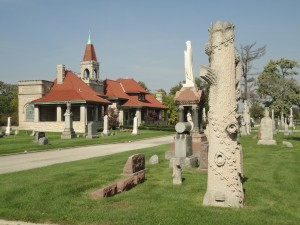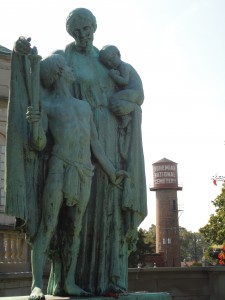
According to its website, the BNC was founded in 1877 “as a result of a Catholic priest denying burial in the Bohemian-Polish Catholic cemetery to those he disliked.” After the refusal to bury Marie Silhanek in 1876, the Bohemian people, led by Mr. Frank Zdrubek of the Bohemian Freethinker’s Society, founded BNC as a permanent resting place regardless one’s religion, nationality, sex, or race.
I first stopped at the monument dedicated to 147 Bohemians killed during the Spanish-American War. The plaque explained that Cuba, the Philippines, and Puerto Rico were Spanish colonies. When the US Battleship Maine got blown up in Havana Bay on February 15, 1898, 266 soldiers were killed. Due to the war effort, the Philippines and Puerto Rico were liberated from Spanish rule.
I then visited a most unique monument, a columbarium, called Beyond the Vines, which was constructed in 2009. The 24’x10′ brick wall has ivy and niches for dedicated Chicago Cub fans! All niches have the Cubs’ logo. One read, “Russell H. Adams Born in 1911 Died in 2009 ‘I saw Ruth & Gehrig play at Wrigley.'” I wonder if Mr. Adams ever forgave Steve Bartman. (See video below.)
BNC has a monument dedicated to Civil War veterans. Names like Hejduk, Kakuska, and Vranek appear. The words “Pro Novou Vlast” are inscribed at the top.
Then came the Chicago history lesson at BNC. First, Anton Cermak became mayor of Chicago in 1931, during the Great Depression, and was shot and killed in Miami as he appeared in a motorcade with President Roosevelt. Mayor Cermak’s mausoleum is inscribed with, as legend has it, his last words, “I am glad it was me instead of you” (meaning FDR).

My conversationalist recommended I watch Jason Robards in “The Day After“, which is a film from 1983 about nuclear war between the Soviet Union and the United States. I explained that I had been born and raised in Minnesota after the Cold War. However, I had lived on Chicago’s north side and it’s “Bungalow Belt” and well as a suburb for half of my life. He replied that Chicagoans learned in high school civics class about the Concentric Ring Theory.
BNC has several large bronze sculptures such as “Mother” and “The Pilgrim” to adorn the grounds as well as an abundance of unusual limestone “Treestones” as grave markers that are at least 8′ tall. I also visited a six-pillared structure dedicated to the International Order of Odd Fellows, which had masonic symbols. Lastly, I stopped to view the World War I and World War II memorials. (BNC does have memorials for any other military conflict.)
I saw a healthy coyote on the property earlier in the day when I was leaving the Beyond the Vines area. I’m sure that particular coyote feasts copiously on geese because he can hide behind gravestones and monuments while hunting.
Friends of Bohemian National Cemetery
Bohemian National Cemetery Reviews on Yelp
More BNC videos from Youtube including a deer which lives on the property, a nighttime concert, and other items of note.


